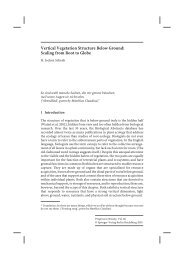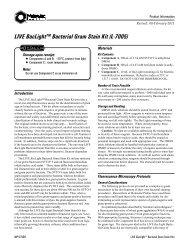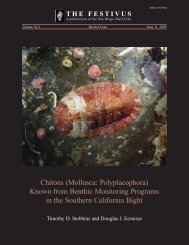Landscape Evolution at an Active Plate Margin - Biological Science ...
Landscape Evolution at an Active Plate Margin - Biological Science ...
Landscape Evolution at an Active Plate Margin - Biological Science ...
Create successful ePaper yourself
Turn your PDF publications into a flip-book with our unique Google optimized e-Paper software.
6.6 (0.4) The “Ball Dome” east of 395 is a doppler<br />
radar, EYX.<br />
12.0 (5.4) Continue past a right turn.<br />
14.0 (2.0) Continue past a road leading east to the<br />
former siding of Fremont on the R<strong>an</strong>dsburg Railroad,<br />
running parallel to Hwy 395. This railroad was active<br />
from 1887 to 1933 (Myrick, 1991), serving rich mines<br />
in R<strong>an</strong>dsburg <strong>an</strong>d Joh<strong>an</strong>nesburg. Because of the<br />
1,200-foot drop into Fremont Valley, a spur to Goler<br />
was never <strong>at</strong>tempted. Processing of the ores from<br />
mines discovered in the R<strong>an</strong>d Mountains initially<br />
proved difficult due to the lack of w<strong>at</strong>er. For this reason<br />
Garlock, with good wells, was the first site of ore<br />
milling oper<strong>at</strong>ions. By 1896 there were 4 short-lived<br />
mills <strong>at</strong> Garlock, one <strong>at</strong> Mesquite Spring, <strong>an</strong>d Charley<br />
Koehn’s mill <strong>at</strong> K<strong>an</strong>e Spring. After the R<strong>an</strong>dsburg<br />
Railroad was completed to Joh<strong>an</strong>nesburg in 1898,<br />
Yellow Aster ore was processed by a 50-stamp mill<br />
in Barstow. A w<strong>at</strong>er line from Garlock to R<strong>an</strong>dsburg<br />
allowed a 30 stamp mill <strong>at</strong> the Yellow Aster mine to<br />
become oper<strong>at</strong>ional in 1899. In 1901 the Yellow Aster<br />
added 100 stamps to the existing b<strong>at</strong>tery.<br />
17.1 (3.1) The R<strong>an</strong>d Hills are <strong>at</strong> 10:00; the 1990s<br />
dumps of the Yellow Aster mine are <strong>at</strong> 11:00; <strong>an</strong>d Red<br />
Mountain is <strong>at</strong> 2:00.<br />
18.8 (1.7) Cross 20 Mule Team Parkway. This road<br />
also leads from Mojave northeast to Blackw<strong>at</strong>er Well,<br />
Gr<strong>an</strong>ite Well <strong>at</strong> Pilot Knob, through P<strong>an</strong>amint Valley<br />
<strong>an</strong>d down Wing<strong>at</strong>e Wash to the Furnace Creek bor<strong>at</strong>e<br />
deposits in De<strong>at</strong>h Valley (Faye, 1999).<br />
21.6 (2.8) Look ahead to excav<strong>at</strong>ions for scheelite<br />
placer mining for in the Atolia Tungsten District.<br />
Scheelite (calcium tungst<strong>at</strong>e, CaWO 4 ) initially bedeviled<br />
dry placer gold miners. They were troubled<br />
by fragments of tungsten since it was heavy (specific<br />
gravity 6.0) <strong>an</strong>d wound up with the gold concentr<strong>at</strong>e.<br />
Scheelite was recognized as valuable in 1903. Claims<br />
purchased by De Golia <strong>an</strong>d Atkins, with a contraction<br />
of names, became “Atolia.” Ore from lode deposits<br />
was initially h<strong>an</strong>d-sorted but a mill was constructed<br />
in 1907. The peak tungsten production, nearly $10<br />
million, was between 1916 to 1918, when Atolia<br />
boasted a payroll of $60,000 per month. The Atolia<br />
Tung–Sun Mining Comp<strong>an</strong>y beg<strong>an</strong> placer mining in<br />
Baltic Gulch in 1942.<br />
21.8 (0.2) Enter the Atolia Mining District. The headframe<br />
of the Union Tungsten Mine c<strong>an</strong> be seen to the<br />
northwest (Fig. 1-1). The Paradox claims are on both<br />
sides of Hwy 395.<br />
D. R. Jessey <strong>an</strong>d R. E. Reynolds<br />
Figure 1-1. Union Tungsten Mine headframe. [J. Westbrook photo]<br />
The district was a major producer of tungsten during<br />
the early 20 th century. At one point, Atolia had a<br />
popul<strong>at</strong>ion in the thous<strong>an</strong>ds (Clark, 1997). Interest in<br />
tungsten deposits continues to the present but little<br />
mining has occurred for the past 40 years. Scheelite,<br />
the main tungsten ore, occurs with quartz <strong>an</strong>d<br />
carbon<strong>at</strong>es along faults in the Jurassic Atolia Quartz<br />
Monzonite (Peck, 1953). The veins strike northwest<br />
<strong>an</strong>d deep steeply to both the north <strong>an</strong>d south. They<br />
consist of coarse grained scheelite, quartz, <strong>an</strong>d calcite,<br />
deposited as open space filling in the fractures. Wall<br />
rock alter<strong>at</strong>ion has caused pervasive alter<strong>at</strong>ion of<br />
biotite to chlorite <strong>an</strong>d feldspar to white mica, carbon<strong>at</strong>e,<br />
<strong>an</strong>d clays. The district was referred to as the “spud<br />
p<strong>at</strong>ch” because of the round, light brown nuggets of<br />
tungsten.<br />
22.9 (1.1) Enter Atolia.<br />
24.7 (1.8) Continue past a left turn to R<strong>an</strong>dsburg.<br />
View northwest of the 1990 Yellow Aster Mine<br />
dumps.<br />
25.1 (0.4) Sign: “Entering Red Mountain.” The Kelly<br />
silver mine structures are to the west, although the<br />
headframe has been dism<strong>an</strong>tled. Initial samples from<br />
the mine assayed 300 ounces of silver with three<br />
ounces of gold per ton. It became California’s largest<br />
silver deposit with over 20 million ounces produced<br />
between 1919 <strong>an</strong>d 1942. The ore occurs in quartz–<br />
carbon<strong>at</strong>e–chalcedony veins. Silver mineraliz<strong>at</strong>ion<br />
consists mainly of Ag–Cu–Sb sulfosalts (miargyrite<br />
<strong>an</strong>d pyrargyrite) <strong>an</strong>d Ag chlorides with minor n<strong>at</strong>ive<br />
silver. Arsenopyrite is the chief g<strong>an</strong>gue mineral.<br />
Due to the difficulty of milling, n<strong>at</strong>ive silver was often<br />
rejected during processing <strong>an</strong>d large nuggets c<strong>an</strong> still<br />
be found on the dumps.<br />
8 2009 Desert Symposium
















